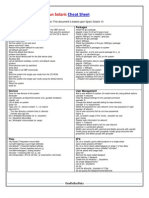Examples of Using Solaris Boot Command
Uploaded by
Carlos QuinteroExamples of Using Solaris Boot Command
Uploaded by
Carlos QuinteroExamples of using Solaris boot command
The solaris boot command when used with various optional parameters will change
the booting behavior.
Syntax
The common syntax of boot command is solaris SPARC system is :
ok> boot [device-specifier] [arguments]
The Common Boot [device-specifier]s are :
1. Disk
2. cdrom
3. net (network boot image)
4. url (jumpstart)
Example 1 : Normal Boot
The boot command without any arguments will boot the system into multi-user mode
by default.
ok> boot
Example 2 :
The -a option will ask for configuration information such as where to find the system
file, where to mount root, and even override the name of the kernel itself. This is very
useful in case of a corrupt /etc/system file or any other such file that may be used in
booting process. Simply enter /dev/null when asked for /etc/system. The default
responses are mentioned in square brackets []. Press enter to select the default
options.
ok> boot -a
Example 3 : Verbose mode
To boot the system in verbose mode :
ok> boot -v
Example 4 : Single user mode
To boot the system into single user mode (init level “s”) use the -s argument. In this
mode all local file systems are mounted and only a small set of essential kernel
processes are left running. This mode is usually used in case of patching the system.
No users can login into the system through network.
ok> boot -s
Example 5 : Non-cluster mode
The -x option is used only in case of sun cluster, to boot into non cluster mode.
ok> boot -x
Example 6 : Reconfiguration boot
When booted in reconfiguration mode, the system will probe all the hardware devices
and update the logical as well as physical namespaces in /dev and /devices
respectively.
ok> boot -r
Example 7 :
The -f argument causes Autoclient systems to flush and reinitialize the client system’s
local cache and read all files over the network from the client’s file server. This flag is
ignored for all non-Autoclient systems.
ok> boot -f
Example 8 :
The -D argument specifies the default file. In general without this option the system will
choose a dynamic default file.
ok> boot -D [default_file]
Example 9 :
The argument -w forces root file system to be mounted as read-write while booting.
But this option is not implemented. The ufs root filesystem is mounted read-only to
avoid problems during fsck. After fsck runs, it is remounted as read-write.
ok> boot -w
Example 10 : SMF options
The -m argument can be used to specify the SMF options for booting the system
ok> boot -m [options]
The various options that can be specified with -m are :
verbose - Print a line for each service as it is started
quiet - Very quiet boot; suppresses standard per-service output and error
messages requiring administrative intervention.
debug - Boot in serial mode, with status logging of service success or
failure output to the console. The stdout and stderr streams of each method
invoked will be connected to the console, as well as the standard logging
facilities smf(5) provides.
milestone=[milestone-level] - Boot to a subgraph defined by the given
milestone.
The various milestone levels are :
none - disable all services.
single-user - roughly the equivalent of run level 1 or S
multi-user - roughly the equivalent of run level 2
multi-user-server - roughly the equivalent of run level 3
all - all enabled services
Example 11 : Failsafe mode
Starting solaris 10 update 6, a ZFS root FS OS can be booted in failsafe mode for
troubleshooting when the OS on the primary boot environment fails to boot.
ok> boot -F failsafe
Example 11 : Boot from bootable ZFS dataset
The -L argument allows booting from specific zfs bootable datasets on the disk. The
bootable datasets are mentioned in /rpool/boot/menu.lst file. This is common to all
datasets under the rpool. Additional entries to the menu.lst are added via the Live
Upgrade process for Boot Environments(BEs). The menu.lst file is updated during the
shutdown process(init 0 | init 6) after an luactivate has been performed.
ok> boot -L
Rebooting with command: boot -L
Boot device: /pci@1f,700000/scsi@2/disk@0,0:a File and args: -L
1. zfsroot
2. zfsroot-with-patch
Select environment to boot: [ 1 - 2 ]: 1
To boot the selected entry, invoke: boot [ root-device ] -Z
rootpool/ROOT/zfsroot
Example 12 :
With the -Z argument, you can directly specify the bootable zfs dataset to boot from.
ok> boot -Z rootpool/ROOT/zfsroot
Network Booting
The SPARC systems can be booted from network either by using RARP/bootparams
or DHCP.
Example 13 : using RARP
When using RARP option to boot over network, the PROM makes a reverse ARP
request. On a reply to this request, the PROM broadcasts a TFTP request to fetch
inetboot over the network from any server that responds and executes it.
ok> boot net:rarp
Example 14 : using DHCP
When using the DHCP option to boot over network, the PROM broadcasts the MAC
address and kernel architecture of the system and requests an IP address, boot
parameters, and network configuration information. On receiving the information from
DHCP server, PROM downloads inetboot, loads that file into memory, and executes it.
inetboot invokes the kernel, which loads the files it needs and releases inetboot.
ok> boot net:dhcp
Troubleshooting
Now various boot arguments discussed above can be used together to troubleshoot a
booting issue. The most commonly used combination of arguments are :
Example 15 : interactive, verbose, single-user using local disk
ok> boot -avs
Example 16 : interactive, verbose, single-user using cdrom
ok> boot cdrom -avs
Example 17 : interactive, verbose, single-user using network
ok> boot net -avs
You might also like
- Assessment of Buffer Overflow Based Attacks On An IoT OSNo ratings yetAssessment of Buffer Overflow Based Attacks On An IoT OS6 pages
- Basic Administration-Commands Solaris11No ratings yetBasic Administration-Commands Solaris1111 pages
- Quick Reference Administering AIX V5.2 Version 1.0: DisclaimerNo ratings yetQuick Reference Administering AIX V5.2 Version 1.0: Disclaimer25 pages
- All Stages of Linux Booting Process Explained0% (1)All Stages of Linux Booting Process Explained12 pages
- SPARC: Setting Up Disks For ZFS File SystemsNo ratings yetSPARC: Setting Up Disks For ZFS File Systems8 pages
- What are the ONTAP maintenance mode commandsNo ratings yetWhat are the ONTAP maintenance mode commands6 pages
- Linux Interview Questions With Answers: Explainthe Boot Process?No ratings yetLinux Interview Questions With Answers: Explainthe Boot Process?111 pages
- Linux Interview Questions On Boot Process and Other Stuff100% (1)Linux Interview Questions On Boot Process and Other Stuff14 pages
- Red Hat Enterprise Linux-9-Boot Options For Rhel Installer-En-UsNo ratings yetRed Hat Enterprise Linux-9-Boot Options For Rhel Installer-En-Us25 pages
- Oracle Solaris Guide For Linux Users: December 2016 (Edition 1.0) Fujitsu LimitedNo ratings yetOracle Solaris Guide For Linux Users: December 2016 (Edition 1.0) Fujitsu Limited74 pages
- Breaking and Syncing A Hardware Root Mirror (Solaris)No ratings yetBreaking and Syncing A Hardware Root Mirror (Solaris)13 pages
- Configuration of a Simple Samba File Server, Quota and Schedule BackupFrom EverandConfiguration of a Simple Samba File Server, Quota and Schedule BackupNo ratings yet
- Configuration of a Simple Samba File Server, Quota and Schedule BackupFrom EverandConfiguration of a Simple Samba File Server, Quota and Schedule BackupNo ratings yet
- DRBD-Cookbook: How to create your own cluster solution, without SAN or NAS!From EverandDRBD-Cookbook: How to create your own cluster solution, without SAN or NAS!No ratings yet
- Free Open Source Linux OS For Data Recovery & Data Rescue Bilingual Version UltimateFrom EverandFree Open Source Linux OS For Data Recovery & Data Rescue Bilingual Version UltimateNo ratings yet
- Evaluation of Some Intrusion Detection and Vulnerability Assessment ToolsFrom EverandEvaluation of Some Intrusion Detection and Vulnerability Assessment ToolsNo ratings yet
- Evaluation of Some Windows and Linux Intrusion Detection ToolsFrom EverandEvaluation of Some Windows and Linux Intrusion Detection ToolsNo ratings yet
- Overview of Some Windows and Linux Intrusion Detection ToolsFrom EverandOverview of Some Windows and Linux Intrusion Detection ToolsNo ratings yet
- Evaluation of Some Windows and Linux Intrusion Detection ToolsFrom EverandEvaluation of Some Windows and Linux Intrusion Detection ToolsNo ratings yet
- Linux - a Secure Personal Computer for Beginners. Second EditionFrom EverandLinux - a Secure Personal Computer for Beginners. Second EditionNo ratings yet
- Operating Systems Interview Questions You'll Most Likely Be AskedFrom EverandOperating Systems Interview Questions You'll Most Likely Be AskedNo ratings yet
- B.Tech II Year I Semester (R13) Supplementary Examinations June 2017No ratings yetB.Tech II Year I Semester (R13) Supplementary Examinations June 20172 pages
- Top 40 Interview Questions On Azure 1721030940No ratings yetTop 40 Interview Questions On Azure 17210309406 pages
- Massive MIMO For Maximal Spectral Efficiency How MNo ratings yetMassive MIMO For Maximal Spectral Efficiency How M17 pages
- ICT Notes+Chapter+6.3+Computer-controlled+systemsNo ratings yetICT Notes+Chapter+6.3+Computer-controlled+systems12 pages
- Manas Kumar Gupta - 1732269124665 - Manas GuptaNo ratings yetManas Kumar Gupta - 1732269124665 - Manas Gupta6 pages
- ATTiny Fuse Reset - Wayne's Tinkering PageNo ratings yetATTiny Fuse Reset - Wayne's Tinkering Page4 pages
- Implementation & Performance Evaluation of AODV ProtocolNo ratings yetImplementation & Performance Evaluation of AODV Protocol4 pages
- Ipc Remote Manager Compact User Manual en-US en-USNo ratings yetIpc Remote Manager Compact User Manual en-US en-US28 pages
- Fdocuments - in Hospital Management System Dbms Project Using Apex 504No ratings yetFdocuments - in Hospital Management System Dbms Project Using Apex 50452 pages
- Sans Community CTF - Fuzzing. by 5n1p3r and Malcom - July 9-11 - 2020 - by Malcom - Jul - 2020 - MediumNo ratings yetSans Community CTF - Fuzzing. by 5n1p3r and Malcom - July 9-11 - 2020 - by Malcom - Jul - 2020 - Medium9 pages

























































































